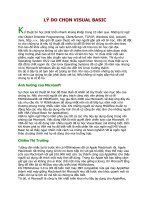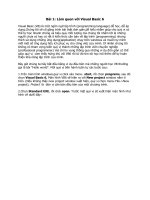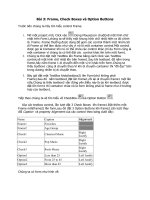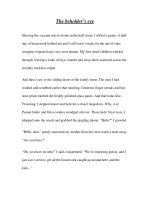Tài liệu The Java EE 6 Tutorial Basic Concepts Fourth Edition pptx
Bạn đang xem bản rút gọn của tài liệu. Xem và tải ngay bản đầy đủ của tài liệu tại đây (18.05 MB, 588 trang )
ptg
www.it-ebooks.info
ptg
The Java EE 6 Tutorial
Basic Concepts
Fourth Edition
www.it-ebooks.info
ptg
This page intentionally left blank
www.it-ebooks.info
ptg
The Java EE 6 Tutorial
Basic Concepts
Fourth Edition
Eric Jendrock, Ian Evans, Devika Gollapudi,
Kim Haase, Chinmayee Srivathsa
Upper Saddle River, NJ • Boston • Indianapolis • San Francisco
New York • Toronto • Montreal • London • Munich • Paris • Madrid
Capetown • Sydney • Tokyo • Singapore • Mexico City
Download from www.wowebook.com
www.it-ebooks.info
ptg
Many of the designations used by manufacturers and sellers to distinguish their products are claimed as trademarks. Where those
designations appear in this book, and the publisher was aware of a trademark claim, the designations have been printed with initial
capital letters or in all capitals.
Oracle and Java are registered trademarks of Oracle and/or its aliates. Other names may be trademarks of their respective owners.
e authors and publisher have taken care in the preparation of this book, but make no expressed or implied warranty of any kind
and assume no responsibility for errors or omissions. No liability is assumed for incidental or consequential damages in connection
with or arising out of the use of the information or programs contained herein.
is document is provided for information purposes only and the contents hereof are subject to change without notice. is
document is not warranted to be error-free, nor subject to any other warranties or conditions, whether expressed orally or implied
in law, including implied warranties and conditions of merchantability or tness for a particular purpose. We specically disclaim
any liability with respect to this document and no contractual obligations are formed either directly or indirectly by this document.
is document may not be reproduced or transmitted in any form or by any means, electronic or mechanical, for any purpose,
without our prior written permission.
e publisher oers excellent discounts on this book when ordered in quantity for bulk purchases or special sales, which may
include electronic versions and/or custom covers and content particular to your business, training goals, marketing focus, and
branding interests. For more information, please contact
U.S . C orporate and Government S ales
(800) 382-3419
For sales outside the United States, please contact
International Sales
Visit us on the Web: informit.com/ph
Library of Congress Cataloging-in-Publication Data
e Java EE 6 tutorial : basic concepts / Eric Jendrock [et al.].
4th ed.
p. cm.
Includes index.
ISBN 0-13-708185-5 (pbk. : alk. paper)
1. Java (Computer program language) 2. Application program interfaces
(Computer soware) 3. Application soware—Development. 4. Internet
programming. I. Jendrock, Eric.
QA76.73.J38J3652 2010
006.7'6 dc22
2010025759
Copyright © 2011, Oracle and/or its aliates. All rights reserved.
500 Oracle Parkway,Redwood Shores,CA94065
Printed in the United States of America. is publication is protected by copyright, and permission must be obtained from
the publisher prior to any prohibited reproduction, storage in a retrieval system, or transmission in any form or by any means,
electronic, mechanical, photocopying, recording, or likewise. For information regarding permissions, write to:
Pearson Education, Inc.
Rights and Contracts Department
501 Boylston Street, Suite 900
Boston, MA 02116
Fax: (617) 671-3447
ISBN-13: 978-013-708185-1
ISBN-10: 0-137-08185-5
Te xt pr i nt e d i n t he Un it e d S tat es on re c y cl e d pa p er a t E d wa r ds Br ot h e rs in A nn A rb o r, Mi c hi g an .
First printing, August, 2010
Download from www.wowebook.com
www.it-ebooks.info
ptg
Contents
Preface xxi
Part I Introduction 1
1 Overview . 3
Java EE 6 Platform Highlights 4
Java EE Application Model 5
Distributed Multitiered Applications 6
Security 7
Java EE Components 8
Java EE Clients 8
Web Components 10
Business Components 11
Enterprise Information System Tier 12
Java EE Containers 13
Container Services 13
Container Types 14
Web Services Support 15
XML 15
SOAP Transport Protocol 16
WSDL Standard Format 16
Java EE Application Assembly and Deployment 17
Packaging Applications 17
Development Roles 19
Java EE Product Provider 20
Tool Provider 20
Application Component Provider 20
v
Download from www.wowebook.com
www.it-ebooks.info
ptg
Application Assembler 21
Application Deployer and Administrator 21
Java EE 6 APIs 22
Enterprise JavaBeans Technology 25
Java Servlet Technology 26
JavaServer Faces Technology 26
JavaServer Pages Technology 27
JavaServer Pages Standard Tag Library 27
Java Persistence API 28
Java Transaction API 28
Java API for RESTful Web Services 28
Managed Beans 28
Contexts and Dependency Injection for the Java EE Platform (JSR 299) 29
Dependency Injection for Java (JSR 330) 29
Bean Validation 29
Java Message Service API 29
Java EE Connector Architecture 29
JavaMail API 30
Java Authorization Contract for Containers 30
Java Authentication Service Provider Interface for Containers 30
Java EE 6 APIs in the Java Platform, Standard Edition 6.0 31
Java Database Connectivity API 31
Java Naming and Directory Interface API 31
JavaBeans Activation Framework 32
Java API for XML Processing 32
Java Architecture for XML Binding 33
SOAP with Attachments API for Java 33
Java API for XML Web Services 33
Java Authentication and Authorization Service 33
GlassFish Server Tools 34
2 Using the Tutorial Examples 37
Required Software 37
Java Platform, Standard Edition 37
Java EE 6 Software Development Kit 38
Contents
The Java EE6Tutorial:Basic Conceptsvi
Download from www.wowebook.com
www.it-ebooks.info
ptg
Java EE 6 Tutorial Component 38
NetBeans IDE 40
Apache Ant 41
Starting and Stopping the GlassFish Server 41
Starting the Administration Console 42
▼ To Start the Administration Console in NetBeans IDE 43
Starting and Stopping the Java DB Server 43
▼ To Start the Database Server Using NetBeans IDE 43
Building the Examples 44
Tutorial Example Directory Structure 44
Getting the Latest Updates to the Tutorial 44
▼ To Update the Tutorial Through the Update Center 45
Debugging Java EE Applications 45
Using the Server Log 45
Using a Debugger 46
Part II The Web Tier 47
3 Getting Started with Web Applications . 49
Web Applications 50
Web Application Lifecycle 51
Web Modules: The hello1 Example 53
Examining the hello1 Web Module 54
Packaging a Web Module 57
Deploying a Web Module 59
Running a Deployed Web Module 59
Listing Deployed Web Modules 60
Updating a Web Module 60
Dynamic Reloading 60
Undeploying Web Modules 61
Conguring Web Applications: The hello2 Example 62
Mapping URLs to Web Components 62
Examining the hello2 Web Module 63
Building, Packaging, Deploying, and Running the hello2 Example 64
Declaring Welcome Files 66
Contents
vii
Download from www.wowebook.com
www.it-ebooks.info
ptg
Setting Context and Initialization Parameters 66
Mapping Errors to Error Screens 67
Declaring Resource References 68
Further Information about Web Applications 71
4 JavaServer Faces Technology 73
What Is a JavaServer Faces Application? 74
JavaServer Faces Technology Benets 75
Creating a Simple JavaServer Faces Application 77
Developing the Backing Bean 77
Creating the Web Page 78
Mapping the FacesServlet Instance 78
The Lifecycle of the hello Application 79
▼ To Build, Package, Deploy, and Run the Application in NetBeans IDE 80
Further Information about JavaServer Faces Technology 81
5 Introduction to Facelets . 83
What Is Facelets? 83
Developing a Simple Facelets Application 85
Creating a Facelets Application 85
Conguring the Application 88
Building, Packaging, Deploying, and Running the guessnumber Facelets
Example 89
Templating 91
Composite Components 94
Resources 96
6 Expression Language 99
Overview of the EL 99
Immediate and Deferred Evaluation Syntax 100
Immediate Evaluation 101
Deferred Evaluation . 101
Value and Method Expressions 102
Value Expressions 102
Method Expressions 106
Contents
The Java EE 6Tutorial:Basic Conceptsviii
Download from www.wowebook.com
www.it-ebooks.info
ptg
Dening a Tag Attribute Type 108
Literal Expressions 109
Operators 111
Reserved Words . 111
Examples of EL Expressions 112
7 Using JavaServer Faces Technology in Web Pages 113
Setting Up a Page . 113
Adding Components to a Page Using HTML Tags 114
Common Component Tag Attributes . 117
Adding HTML Head and Body Tags . 119
Adding a Form Component . 120
Using Text Components . 121
Using Command Component Tags for Performing Actions and Navigation 126
Adding Graphics and Images with the h:graphicImage Tag . 127
Laying Out Components with the h:panelGrid and h:panelGroup Tags . 128
Displaying Components for Selecting One Value 130
Displaying Components for Selecting Multiple Values 132
Using the f:selectItem and f:selectItems Tags . 133
Using Data-Bound Table Components . 135
Displaying Error Messages with the h:message and h:messages Tags . 138
Creating Bookmarkable URLs with the h:button and h:link Tags . 139
Using View Parameters to Congure Bookmarkable URLs 140
Resource Relocation Using h:output Tags . 141
Using Core Tags 143
8 Using Converters, Listeners, and Validators . 145
Using the Standard Converters 145
Converting a Component’s Value . 146
Using DateTimeConverter . 147
Using NumberConverter . 149
Registering Listeners on Components . 151
Registering a Value-Change Listener on a Component . 151
Registering an Action Listener on a Component . 152
Using the Standard Validators 152
Contents
ix
Download from www.wowebook.com
www.it-ebooks.info
ptg
Validating a Component’s Value . 153
Using LongRangeValidator . 154
Referencing a Backing Bean Method . 154
Referencing a Method That Performs Navigation . 155
Referencing a Method That Handles an Action Event 156
Referencing a Method That Performs Validation . 156
Referencing a Method That Handles a Value-Change Event 156
9 Developing with JavaServer Faces Technology . 159
Backing Beans 159
Creating a Backing Bean 160
Using the EL to Reference Backing Beans 161
Writing Bean Properties 162
Writing Properties Bound to Component Values 163
Writing Properties Bound to Component Instances 168
Writing Properties Bound to Converters, Listeners, or Validators 170
Writing Backing Bean Methods 170
Writing a Method to Handle Navigation 171
Writing a Method to Handle an Action Event 172
Writing a Method to Perform Validation 173
Writing a Method to Handle a Value-Change Event 173
Using Bean Validation 174
Validating Null and Empty Strings 177
10 Java Servlet Technology 179
What Is a Servlet? 180
Servlet Lifecycle 180
Handling Servlet Lifecycle Events 180
Handling Servlet Errors . 182
Sharing Information 182
Using Scope Objects 182
Controlling Concurrent Access to Shared Resources 183
Creating and Initializing a Servlet 183
Writing Service Methods . 184
Getting Information from Requests 185
Contents
The Java EE 6Tutorial:Basic Conceptsx
Download from www.wowebook.com
www.it-ebooks.info
ptg
Constructing Responses 186
Filtering Requests and Responses 187
Programming Filters 187
Programming Customized Requests and Responses 188
Specifying Filter Mappings 189
Invoking Other Web Resources . 191
Including Other Resources in the Response 192
Transferring Control to Another Web Component . 192
Accessing the Web Context 193
Maintaining Client State 193
Accessing a Session 193
Associating Objects with a Session 193
Session Management 194
Session Tracking . 195
Finalizing a Servlet . 195
Tracking Service Requests 196
Notifying Methods to Shut Down 196
Creating Polite Long-Running Methods 197
The mood Example Application . 198
Components of the mood Example Application 198
Building, Packaging, Deploying, and Running the mood Example 198
Further Information about Java Servlet Technology 200
Part III Web Services 201
11 Introduction to Web Services . 203
What Are Web Services? 203
Types of Web Services 203
“Big” Web Services 204
RESTful Web Services 204
Deciding Which Type of Web Service to Use 206
12 Building Web Services with JAX-WS . 207
Creating a Simple Web Service and Clients with JAX-WS 208
Contents
xi
Download from www.wowebook.com
www.it-ebooks.info
ptg
Requirements of a JAX-WS Endpoint 209
Coding the Service Endpoint Implementation Class 210
Building, Packaging, and Deploying the Service 210
Testing the Methods of a Web Service Endpoint 211
A Simple JAX-WS Application Client 212
A Simple JAX-WS Web Client 214
Types Supported by JAX-WS 217
Web Services Interoperability and JAX-WS 217
Further Information about JAX-WS 217
13 Building RESTful Web Services with JAX-RS 219
What Are RESTful Web Services? 219
Creating a RESTful Root Resource Class 220
Developing RESTful Web Services with JAX-RS 221
Overview of a JAX-RS Application . 222
The @Path Annotation and URI Path Templates . 223
Responding to HTTP Resources . 226
Using @Consumes and @Produces to Customize Requests and Responses . 229
Extracting Request Parameters 231
Example Applications for JAX-RS 235
A RESTful Web Service 235
The rsvp Example Application 237
Real-World Examples 240
Further Information about JAX-RS . 240
Part IV Enterprise Beans . 243
14 Enterprise Beans 245
What Is an Enterprise Bean? 245
Benets of Enterprise Beans 246
When to Use Enterprise Beans 246
Types of Enterprise Beans . 246
What Is a Session Bean? 247
Types of Session Beans 247
Contents
The Java EE 6Tutorial:Basic Conceptsxii
Download from www.wowebook.com
www.it-ebooks.info
ptg
When to Use Session Beans . 248
What Is a Message-Driven Bean? . 249
What Makes Message-Driven Beans Dierent from Session Beans? 249
When to Use Message-Driven Beans . 251
Accessing Enterprise Beans 251
Using Enterprise Beans in Clients 252
Deciding on Remote or Local Access . 253
Local Clients . 254
Remote Clients . 255
Web Service Clients . 256
Method Parameters and Access . 257
The Contents of an Enterprise Bean . 258
Packaging Enterprise Beans in EJB JAR Modules 258
Packaging Enterprise Beans in WAR Modules . 259
Naming Conventions for Enterprise Beans . 260
The Lifecycles of Enterprise Beans . 261
The Lifecycle of a Stateful Session Bean 261
The Lifecycle of a Stateless Session Bean . 262
The Lifecycle of a Singleton Session Bean 262
The Lifecycle of a Message-Driven Bean 263
Further Information about Enterprise Beans . 264
15 Getting Started with Enterprise Beans . 265
Creating the Enterprise Bean . 265
Coding the Enterprise Bean Class 266
Creating the converter Web Client . 266
Building, Packaging, Deploying, and Running the converter Example . 267
Modifying the Java EE Application . 269
▼ To Modify a Class File 269
16 Running the Enterprise Bean Examples . 271
The cart Example 271
The Business Interface 272
Session Bean Class 273
The @Remove Method . 276
Contents
xiii
Download from www.wowebook.com
www.it-ebooks.info
ptg
Helper Classes 276
Building, Packaging, Deploying, and Running the cart Example 276
A Singleton Session Bean Example: counter . 278
Creating a Singleton Session Bean . 278
The Architecture of the counter Example 283
Building, Packaging, Deploying, and Running the counter Example 285
A Web Service Example: helloservice . 286
The Web Service Endpoint Implementation Class . 287
Stateless Session Bean Implementation Class . 287
Building, Packaging, Deploying, and Testing the helloservice Example . 288
Using the Timer Service 290
Creating Calendar-Based Timer Expressions 290
Programmatic Timers . 293
Automatic Timers . 294
Canceling and Saving Timers . 296
Getting Timer Information . 296
Transactions and Timers . 296
The timersession Example . 297
Building, Packaging, Deploying, and Running the timersession Example . 299
Handling Exceptions 300
Part V Contexts and Dependency Injection for the Java EE Platform . 303
17 Introduction to Contexts and Dependency Injection for the Java EE Platform 305
Overview of CDI 306
About Beans 307
About Managed Beans 307
Beans as Injectable Objects 308
Using Qualiers 309
Injecting Beans 310
Using Scopes 310
Giving Beans EL Names 312
Adding Setter and Getter Methods 312
Using a Managed Bean in a Facelets Page 313
Injecting Objects by Using Producer Methods 314
Contents
The Java EE 6Tutorial:Basic Conceptsxiv
Download from www.wowebook.com
www.it-ebooks.info
ptg
Conguring a CDI Application 315
Further Information about CDI 315
18 Running the Basic Contexts and Dependency Injection Examples 317
The simplegreeting CDI Example . 317
The simplegreeting Source Files . 318
The Facelets Template and Page 318
Conguration Files 319
Building, Packaging, Deploying, and Running the simplegreeting CDI
Example 320
The guessnumber CDI Example . 322
The guessnumber Source Files . 322
The Facelets Page 326
Building, Packaging, Deploying, and Running the guessnumber CDI
Example 328
Part VI Persistence 331
19 Introduction to the Java Persistence API . 333
Entities 333
Requirements for Entity Classes . 334
Persistent Fields and Properties in Entity Classes 334
Primary Keys in Entities . 339
Multiplicity in Entity Relationships . 341
Direction in Entity Relationships . 342
Embeddable Classes in Entities . 344
Entity Inheritance . 345
Abstract Entities 345
Mapped Superclasses 345
Non-Entity Superclasses 346
Entity Inheritance Mapping Strategies 347
Managing Entities 349
The EntityManager Interface . 349
Persistence Units 353
Querying Entities 355
Contents
xv
Download from www.wowebook.com
www.it-ebooks.info
ptg
Further Information about Persistence . 355
20 Running the Persistence Examples . 357
The order Application . 357
Entity Relationships in the order Application 358
Primary Keys in the order Application . 360
Entity Mapped to More Than One Database Table 363
Cascade Operations in the order Application 363
BLOB and CLOB Database Types in the order Application . 364
Temporal Types in the order Application . 365
Managing the order Application’s Entities . 365
Building, Packaging, Deploying, and Running the order Application 368
The roster Application 369
Relationships in the roster Application . 369
Entity Inheritance in the roster Application 370
Criteria Queries in the roster Application 372
Automatic Table Generation in the roster Application 374
Building, Packaging, Deploying, and Running the roster Application 374
The address-book Application 376
Bean Validation Constraints in address-book . 376
Specifying Error Messages for Constraints in address-book 377
Validating Contact Input from a JavaServer Faces Application 378
Building, Packaging, Deploying, and Running the address-book Application .379
21 The Java Persistence Query Language 381
Query Language Terminology 382
Creating Queries Using the Java Persistence Query Language 382
Named Parameters in Queries 383
Positional Parameters in Queries . 383
Simplied Query Language Syntax 384
Select Statements 384
Update and Delete Statements 385
Example Queries 385
Simple Queries 385
Queries That Navigate to Related Entities 386
Contents
The Java EE 6Tutorial:Basic Conceptsxvi
Download from www.wowebook.com
www.it-ebooks.info
ptg
Queries with Other Conditional Expressions . 388
Bulk Updates and Deletes . 389
Full Query Language Syntax 390
BNF Symbols 390
BNF Grammar of the Java Persistence Query Language 391
FROM Clause 394
Path Expressions 398
WHERE Clause 400
SELECT Clause . 410
ORDER BY Clause 412
GROUP BY and HAVING Clauses 412
22 Using the Criteria API to Create Queries 415
Overview of the Criteria and Metamodel APIs 415
Using the Metamodel API to Model Entity Classes 417
Using Metamodel Classes . 418
Using the Criteria API and Metamodel API to Create Basic Typesafe Queries . 418
Creating a Criteria Query . 418
Query Roots . 419
Querying Relationships Using Joins 420
Path Navigation in Criteria Queries 421
Restricting Criteria Query Results 421
Managing Criteria Query Results 424
Executing Queries 425
Part VII Security 427
23 Introduction to Security in the Java EE Platform 429
Overview of Java EE Security 430
A Simple Security Example . 430
Features of a Security Mechanism . 433
Characteristics of Application Security 434
Security Mechanisms 435
Java SE Security Mechanisms . 435
Contents
xvii
Download from www.wowebook.com
www.it-ebooks.info
ptg
Java EE Security Mechanisms 436
Securing Containers . 439
Using Annotations to Specify Security Information . 439
Using Deployment Descriptors for Declarative Security 439
Using Programmatic Security . 440
Securing the GlassFish Server 440
Working with Realms, Users, Groups, and Roles 441
What Are Realms, Users, Groups, and Roles? . 441
Managing Users and Groups on the GlassFish Server 444
Setting Up Security Roles . 446
Mapping Roles to Users and Groups 447
Establishing a Secure Connection Using SSL . 449
Verifying and Conguring SSL Support . 450
Working with Digital Certicates . 450
Further Information about Security 454
24 Getting Started SecuringWeb Applications 455
Overview of Web Application Security . 455
Securing Web Applications . 457
Specifying Security Constraints . 457
Specifying Authentication Mechanisms 461
Declaring Security Roles . 468
Using Programmatic Security with Web Applications . 469
Authenticating Users Programmatically . 469
Checking Caller Identity Programmatically 471
Example Code for Programmatic Security 472
Declaring and Linking Role References 473
Examples: Securing Web Applications . 474
▼ To Set Up Your System for Running the Security Examples 474
Example: Basic Authentication with a Servlet 475
Example: Form-Based Authentication with a JavaServer Faces Application 479
25 Getting Started Securing Enterprise Applications . 485
Securing Enterprise Beans . 486
Securing an Enterprise Bean Using Declarative Security 489
Contents
The Java EE 6Tutorial:Basic Conceptsxviii
Download from www.wowebook.com
www.it-ebooks.info
ptg
Securing an Enterprise Bean Programmatically . 493
Propagating a Security Identity (Run-As) . 494
Deploying Secure Enterprise Beans . 496
Examples: Securing Enterprise Beans . 496
Example: Securing an Enterprise Bean with Declarative Security . 497
Example: Securing an Enterprise Bean with Programmatic Security 501
Securing Application Clients . 504
Using Login Modules 505
Using Programmatic Login 505
Securing Enterprise Information Systems Applications . 506
Container-Managed Sign-On . 506
Component-Managed Sign-On 506
Conguring Resource Adapter Security 507
▼ To Map an Application Principal to EIS Principals . 508
Part VIII Java EE Supporting Technologies 511
26 Introduction to Java EE Supporting Technologies . 513
Transactions . 513
Resources . 514
The Java EE Connector Architecture and Resource Adapters . 514
Java Message Service . 514
Java Database Connectivity Software . 515
27 Transactions 517
What Is a Transaction? 517
Container-Managed Transactions 518
Transaction Attributes 519
Rolling Back a Container-Managed Transaction 523
Synchronizing a Session Bean’s Instance Variables 523
Methods Not Allowed in Container-Managed Transactions 523
Bean-Managed Transactions . 524
JTA Transactions 524
Returning without Committing 525
Contents
xix
Download from www.wowebook.com
www.it-ebooks.info
ptg
Methods Not Allowed in Bean-Managed Transactions . 525
Transaction Timeouts . 525
▼ To Set a Transaction Timeout 526
Updating Multiple Databases . 526
Transactions in Web Components . 528
Further Information about Transactions 528
28 Resource Connections 529
Resources and JNDI Naming 529
DataSource Objects and Connection Pools . 530
Resource Injection 531
Field-Based Injection 532
Method-Based Injection 533
Class-Based Injection 534
Resource Adapters and Contracts 534
Management Contracts 536
Generic Work Context Contract 537
Outbound and Inbound Contracts 537
Metadata Annotations 538
Common Client Interface 540
Further Information about Resources 541
Index 543
Contents
The Java EE 6Tutorial:Basic Conceptsxx
Download from www.wowebook.com
www.it-ebooks.info
ptg
Preface
This tutorial is a guide to developing enterprise applications for the Java Platform,
Enterprise Edition 6 (Java EE 6) using GlassFish Server Open Source Edition.
Oracle GlassFish Server, a Java EE compatible application server, is based on GlassFish
Server Open Source Edition, the leading open-source and open-community platform
for building and deploying next-generation applications and services. GlassFish Server
Open Source Edition, developed by the GlassFish project open-source community at
is the rst compatible implementation of the
Java EE 6 platform specication. This lightweight, exible, and open-source
application server enables organizations not only to leverage the new capabilities
introduced within the Java EE 6 specication, but also to add to their existing
capabilities through a faster and more streamlined development and deployment
cycle. Oracle GlassFish Server, the product version, and GlassFish Server Open Source
Edition, the open-source version, are hereafter referred to as GlassFish Server.
The following topics are addressed here:
■
“Before You Read This Book” on page xxi
■
“Oracle GlassFish Server Documentation Set” on page xxii
■
“Related Documentation” on page xxiv
■
“Symbol Conventions” on page xxiv
■
“Typographic Conventions” on page xxv
■
“Default Paths and File Names” on page xxv
■
“Documentation, Support, and Training” on page xxvi
■
“Searching Oracle Product Documentation” on page xxvii
■
“Third-Party Web Site References” on page xxvii
Before You Read This Book
Before proceeding with this tutorial, you should have a good knowledge of the Java
programming language. A good way to get to that point is to work through The Java
Tutorial, Fourth Edition, Sharon Zakhour et al. (Addison-Wesley, 2006).
xxi
Download from www.wowebook.com
www.it-ebooks.info
ptg
Oracle GlassFish Server Documentation Set
The GlassFish Server documentation set describes deployment planning and system
installation. The Uniform Resource Locator (URL) for GlassFish Server
documentation is For an introduction to
GlassFish Server, refer to the books in the order in which they are listed in the
following table.
TABLE P–1 Books in the GlassFish Server Documentation Set
Book Title Description
Release Notes Provides late-breaking information about the software and the
documentation and includes a comprehensive, table-based summary
of the supported hardware, operating system, Java Development Kit
(JDK), and database drivers.
Quick Start Guide Explains how to get started with the GlassFish Server product.
Installation Guide Explains how to install the software and its components.
Upgrade Guide Explains how to upgrade to the latest version of GlassFish Server.
This guide also describes dierences between adjacent product
releases and conguration options that can result in incompatibility
with the product specications.
Administration Guide Explains how to congure, monitor, and manage GlassFish Server
subsystems and components from the command line by using the
asadmin(1M) utility. Instructions for performing these tasks from the
Administration Console are provided in the Administration Console
online help.
Application Deployment
Guide
Explains how to assemble and deploy applications to the GlassFish
Server and provides information about deployment descriptors.
Your First Cup: An
Introduction to the Java EE
Platform
For beginning Java EE programmers, provides a short tutorial that
explains the entire process for developing a simple enterprise
application. The sample application is a web application that consists
of a component that is based on the Enterprise JavaBeans
specication, a JAX-RS web service, and a JavaServer Faces
component for the web front end.
Application Development
Guide
Explains how to create and implement Java Platform, Enterprise
Edition (Java EE platform) applications that are intended to run on
the GlassFish Server. These applications follow the open Java
standards model for Java EE components and application
programmer interfaces (APIs). This guide provides information
about developer tools, security, and debugging.
Preface
The Java EE 6Tutorial:Basic Conceptsxxii
Download from www.wowebook.com
www.it-ebooks.info
ptg
TABLE P–1 Books in the GlassFish Server Documentation Set (Continued)
Book Title Description
Add-On Component
Development Guide
Explains how to use published interfaces of GlassFish Server to
develop add-on components for GlassFish Server. This document
explains how to perform only those tasks that ensure that the add-on
component is suitable for GlassFish Server.
Embedded Server Guide Explains how to run applications in embedded GlassFish Server and
to develop applications in which GlassFish Server is embedded.
Scripting Framework Guide Explains how to develop scripting applications in such languages as
Ruby on Rails and Groovy on Grails for deployment to GlassFish
Server.
Troubleshooting Guide Describes common problems that you might encounter when using
GlassFish Server and explains how to solve them.
Error Message Reference Describes error messages that you might encounter when using
GlassFish Server.
Reference Manual Provides reference information in man page format for GlassFish
Server administration commands, utility commands, and related
concepts.
Domain File Format
Reference
Describes the format of the GlassFish Server conguration le,
domain.xml.
Java EE 6 Tutorial Explains how to use Java EE 6 platform technologies and APIs to
develop Java EE applications.
Message Queue Release
Notes
Describes new features, compatibility issues, and existing bugs for
GlassFish Message Queue.
Message Queue
Administration Guide
Explains how to set up and manage a Message Queue messaging
system.
Message Queue Developer’s
Guide for JMX Clients
Describes the application programming interface in Message Queue
for programmatically conguring and monitoring Message Queue
resources in conformance with the Java Management Extensions
(JMX).
Preface
xxiii
Download from www.wowebook.com
www.it-ebooks.info
ptg
Related Documentation
Javadoc tool reference documentation for packages that are provided with GlassFish
Server is available as follows.
■
The API specication for version 6 of Java EE is located at http://
download.oracle.com/docs/cd/E17410_01/javaee/6/api/.
■
The API specication for GlassFish Server 3.0.1, including Java EE 6 platform
packages and nonplatform packages that are specic to the GlassFish Server
product, is located at />Additionally, the Java EE Specications at />java/javaee/tech/index.html might be useful.
For information about creating enterprise applications in the NetBeans Integrated
Development Environment (IDE), see />For information about the Java DB database for use with the GlassFish Server, see
/>The GlassFish Samples project is a collection of sample applications that demonstrate
a broad range of Java EE technologies. The GlassFish Samples are bundled with the
Java EE Software Development Kit (SDK) and are also available from the GlassFish
Samples project page at />Symbol Conventions
The following table explains symbols that might be used in this book.
TABLE P–2 SymbolConventions
Symbol Description Example Meaning
[] Contains optional
arguments and command
options.
ls [-l] The -l option is not required.
{|} Contains a set of choices
for a required command
option.
-d {y|n} The -d option requires that you
use either the y argument or the n
argument.
${ } Indicates a variable
reference.
${com.sun.javaRoot} References the value of the
com.sun.javaRoot variable.
- Joins simultaneous
multiple keystrokes.
Control-A Press the Control key while you
press the A key.
Preface
The Java EE 6Tutorial:Basic Conceptsxxiv
Download from www.wowebook.com
www.it-ebooks.info









